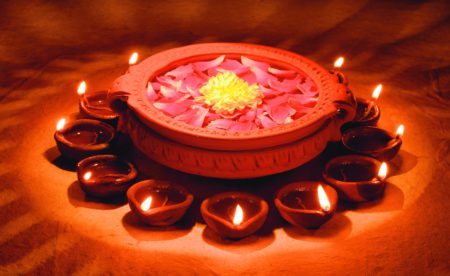‘Ga’ denotes Buddhi (intellect), ‘Na’ symbolizes Vijnana (knowledge), and ‘pati’ means leader. This makes Ganapati the master of wisdom and intellect. Isn’t it ironic that today, we perform Ganesh puja without actually understanding His form or its significance?
Why is he half man, half animal, and yet considered divine? Why is he so big and yet riding on a meek mouse? He has a big stomach, broken tusks, modak (sweet) in his hand, and a snake around his belly. His form has indeed been an amusement to some, a target of criticism for some, and certainly a mystery to many.
The physical attributes of Lord Ganesha are replete with spiritual symbolisms. In their profound wisdom, ancient seers of the Vedic times chose to embody their learning in symbols and forms to define the formless through the form. Words change over time while symbols outlast time itself. Words leave nothing for the seeker to find, while forms can be understood by people of all ages, universally, depending on the stage of their spiritual progress.
Here is our humble attempt to present to you our understanding of the divine energy, Lord Ganesha, in the hope that we all carry this wisdom with us as we celebrate this festival. The worship of Lord Ganesha is not the worship of an idol but a prayer to the Universal energy to imbibe in us the positive qualities He represents.
“Viyate Nayake Iti Vinayaka” – Vinayaka is he who is a master unto Himself. He is the true leader.
THE BIG HEAD OF AN ELEPHANT – THINK BIG
The big head of an elephant kept on a human body suggests how we should ideally function: wisdom and intellect – Elephants have the largest brains of all land animals. They are accepted among the world’s most intelligent species. Along with the intelligence, an elephant has also been known for its wisdom. Likewise, a leader must possess a comprehensive understanding and a discriminating intellect.
Power and compassion
An elephant is affectionate, loyal, kind (eating no meat), gentle, and yet powerful beyond comparison, destroying forests and armies.
Relentless determination
When Faced with obstacles, they neither sidestep them nor are deterred by them. They remove them and forge ahead. It suggests we be strong enough to face life’s challenges while retaining the sensitivities to explore our inner world.
SMALL EYES – SEE THE BIGGER PICTURE
While an elephant has small eyes and poor vision, it also has the natural ability to see things bigger than they actually are. This is a suggestion to us not to pay so much attention to the visual world as it can often misinterpret realities even when we do see the whole picture.
LARGE EARS – LISTEN MORE
The ears of the elephant are used to funnel in sound waves from the environment, contributing to its keen sense of hearing. Likewise, we need to listen a lot to many people, winnow out the unnecessary, and then assimilate our own ideas.
THE FLEXIBLE TRUNK – BE ADAPTABLE
An elephant’s trunk is one of the most versatile instruments known, performing gross and subtle actions. It is strong enough to push 600 kg logs while also sensitive enough to be able to pick up a small coin off the ground. He can use its trunk to caress and play and also destroy. It teaches that a true leader must have intellectual discrimination (vivek), adaptability, and strength.
WIDE MOUTH – CELEBRATE LIFE
The natural desire to enjoy life in the physical world.
BROKEN TUSK – BE FREE FROM ORDERLINESS
Two tusks symbolize opposites – good and evil, emotion and logic, etc. With his one broken or removed tusk, Bhagwan Ganesh denotes a rise from dualities. It teaches us to think beyond the parameters of black and white and instead transcend over them, for it is only when we cease to conform and be bound to the play of opposites we will be free to appreciate universal oneness.
BIG STOMACH – BE BIG-HEARTED
A true leader must be able ‘to stomach,’ absorb, and digest all the trials and tribulations of the world and the capacity to remain composed through the good and the bad. It also suggests to ‘have a stomach’ to keep in confidence all the confiding of people.
THE FOUR HANDS – THINK ON ALL LEVELS
His four arms indicate that He is present in all directions. They stand for the four forms of the subtle or inner mind: Mana (mind), Buddhi (intellect), Chitta (memory/consciousness), and Ahamkara (ego) and the objects how to control these;-
The axe-bearing hand
dissolution of the ego; the anushka (elephant goad) represents the destruction of the ego and desires while prodding us toward righteousness and truth
The noose-bearing hand
control of the mind; the pasha (noose) symbolizes the rope of spiritual wisdom, the force that will remove us from the material world and its attachments. The rope ties down the wild elephant-like mind, which runs from here to there. It controls and tames it.
The lotus-bearing hand
awakening of consciousness; the padma denotes the divine state of being that every aspirant seeks consciously and unconsciously. Just as the lotus blooms unaffected even in dirty waters, similarly, we must strive to enjoy life and yet be above it all by identifying with our inner realized Self.
The blessing hand
Abhaya Mudra blesses the seeker in his pursuit of intellect and offers refuge and protection.
MODAKA SWEET– SEEK THE REWARD OF PENANCE
The sweet Modaka derives its name from ‘mode,’ which means bliss, and ‘ka’ means a small part or cavity. Its shape resembles a coconut, with a rugged exterior with an inner cavity. The hard exterior denotes the difficulties one must overcome to reach the inner bliss. The tip of the modak is narrow, similar to spiritual knowledge at the start.
However, when one seeks deeper, and the kundalini (spiritual energy) reaches the ‘kha’ cavity, the spiritual experience of bliss is obtained (the sweet filling in the modak). Its pure white exterior symbolizes spiritual knowledge, and being held in Sri Ganesha’s hand signifies the reward or sweet fruits of sadhana, spiritual pursuit.
MOOSHAKA MOUSE – RIDE THE DESIRES BUT KEEP THEM IN CONTROL
From the Sanskrit- “mus” – meaning “to steal,” the Musuka has been likened to the rats in our lives (problems, irritations, issues), the greedy thieves who gnaw into our sense of well-being and steal our peace.
It represents;
- base desires (Vaasana) that can distract us, and sitting at Lord Ganesha’s feet shows that they must be overcome
- symbol of darkness (since nocturnal), and Lord Ganesha represents knowledge, which brings light
- ego that can nibble all that is good and noble in a person, Lord Ganesha, riding atop him, denotes conquest over egoism to attain wisdom.
- Finally, as rats generally succeed in gnawing their way through every obstruction, as His vehicle he symbolizes Ganesha’s ability to destroy every obstacle.
TRAY OF LADOOS WITH THE MOUSE LOOKING ON
A mouse gazing at the sweets placed by Lord Ganesha’s foot but not consuming them indicates an ego that has been controlled and can remain unaffected by material temptations. The sweets represent wealth, power, and prosperity, and their place at His foot denotes that if you do live a life of high ideals & principles, these material benefits will always be available for you. The lesson is not to be attached to them.
ONE LEG FOLDED AND ONE RESTING ON THE GROUND – AIM FOR THE SKY WHILE REMAINING ROOTED
The foot on the ground tells us that while we must remain in the world, we must continuously seek to align with our inner self (the pointing upwards folded foot). We must strive for an unwavering focus on our higher aims of existence. Our spiritual goals.






